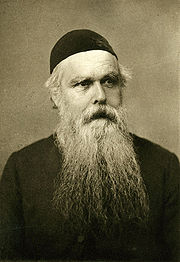
Reverend Henry Whitehead
Encyclopedia

Church of England
The Church of England is the officially established Christian church in England and the Mother Church of the worldwide Anglican Communion. The church considers itself within the tradition of Western Christianity and dates its formal establishment principally to the mission to England by St...
cleric
Clergy
Clergy is the generic term used to describe the formal religious leadership within a given religion. A clergyman, churchman or cleric is a member of the clergy, especially one who is a priest, preacher, pastor, or other religious professional....
and the assistant curate
Curate
A curate is a person who is invested with the care or cure of souls of a parish. In this sense "curate" correctly means a parish priest but in English-speaking countries a curate is an assistant to the parish priest...
at St. Luke's church in Soho
Soho
Soho is an area of the City of Westminster and part of the West End of London. Long established as an entertainment district, for much of the 20th century Soho had a reputation for sex shops as well as night life and film industry. Since the early 1980s, the area has undergone considerable...
, London
London
London is the capital city of :England and the :United Kingdom, the largest metropolitan area in the United Kingdom, and the largest urban zone in the European Union by most measures. Located on the River Thames, London has been a major settlement for two millennia, its history going back to its...
during the 1854 cholera
Cholera
Cholera is an infection of the small intestine that is caused by the bacterium Vibrio cholerae. The main symptoms are profuse watery diarrhea and vomiting. Transmission occurs primarily by drinking or eating water or food that has been contaminated by the diarrhea of an infected person or the feces...
outbreak.
A believer in the miasma theory of disease
Miasma theory of disease
The miasma theory held that diseases such as cholera, chlamydia or the Black Death were caused by a miasma , a noxious form of "bad air"....
, Whitehead worked to disprove false theories, eventually coming to prefer Dr. John Snow's
John Snow (physician)
John Snow was an English physician and a leader in the adoption of anaesthesia and medical hygiene. He is considered to be one of the fathers of epidemiology, because of his work in tracing the source of a cholera outbreak in Soho, England, in 1854.-Early life and education:Snow was born 15 March...
idea that cholera spreads through water contaminated by human waste. Snow's work, particularly his maps of the Soho area cholera victims, convinced Whitehead that the Broad Street pump was the source of the local infections. Whitehead then joined with Snow in tracking the contamination to a faulty cesspool and the outbreak's index case
Whitehead's work with Snow combined demographic
Demographics
Demographics are the most recent statistical characteristics of a population. These types of data are used widely in sociology , public policy, and marketing. Commonly examined demographics include gender, race, age, disabilities, mobility, home ownership, employment status, and even location...
study with scientific observation, setting important precedent for the burgeoning science of epidemiology
Epidemiology
Epidemiology is the study of health-event, health-characteristic, or health-determinant patterns in a population. It is the cornerstone method of public health research, and helps inform policy decisions and evidence-based medicine by identifying risk factors for disease and targets for preventive...
Whitehead served as a clergyman in several other London parishes before moving to Newlands in Cumberland
Cumberland
Cumberland is a historic county of North West England, on the border with Scotland, from the 12th century until 1974. It formed an administrative county from 1889 to 1974 and now forms part of Cumbria....
in 1884, and finally to become vicar of Lanercost
Lanercost Priory
Lanercost Priory was founded by Robert de Vaux between 1165 and 1174, the most likely date being 1169, to house Augustinian Canons. It is situated at the village of Lanercost, Cumbria, England, within sight of Naworth Castle, with which it long had close connections.It is now open to the public and...
for five years until his death.
External links
- "The Broad Street Pump:An Episode in th Cholera Epidemic of 1854", The Reverend H. Whitehead in Macmillan's Magazine, Volume XIII, Nov. 1865 - Apr. 1886, pp. 113-122

